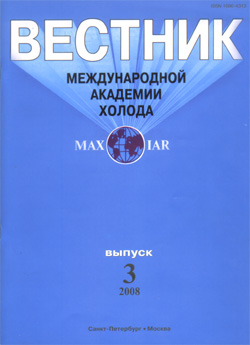
Thermodynamic efficiency of heat pump systems

Annotation
Presented here are the results of the analysis on the efficiency of using a wide range of substances as working media in heat pump systems. The analysis was based on the techniques developed by the authors who suggested equal temperature pressures between a heat transfer agent and working medium in the evaporator and condenser with fixed parameters of heat transfer agents in heat exchangers. Besides, prerequisites and criteria have been formulated and analyzed for regenerative cycles used in such systems with the purpose of increasing their thermodynamic efficiency. The set of substances best suited for this purpose has been identified.
Keywords
Постоянный URL
Articles in current issue
- 20th Anniversary of the International Academy of Refrigeration
- From history of the International Academy of Refrigeration
- Congratulations on the anniversary!
- Representative Branch on the IAR in Belarus
- Information on the activities of the regional division of the International Academy of Refrigeration in Tatarstan
- Representative Branch of the International Academy of Refrigeration in the Republic of Kazakhstan
- History and development of food technologies at the Kaliningrad Division of the IAR
- The anniversaries of the International Academy of Refrigeration and Kemerovo Technological Institute of Food Industry
- Significant date: the 20th anniversary of the International Academy of Refrigeration
- Food security and refrigerating technology
- Mikhail Lomonosov about the nature of heat and cold
- Vacuum vaporizer refrigerating systems
- An air-cooling block preceding the compressor in an ammonia production unit
- Modern IT monitoring systems for cryogenic storage of biomaterial in an umbilical blood bank
- The use of sorbent-based dehumidifiers in air-conditioning systems
- Researching oscillatory movement of a gas gimbal in the rotor of turbo-refrigerating and gas expansion machines. Part II. Pressure fluctuations in the nozzles of a feeding system operating in a supercritical mode
